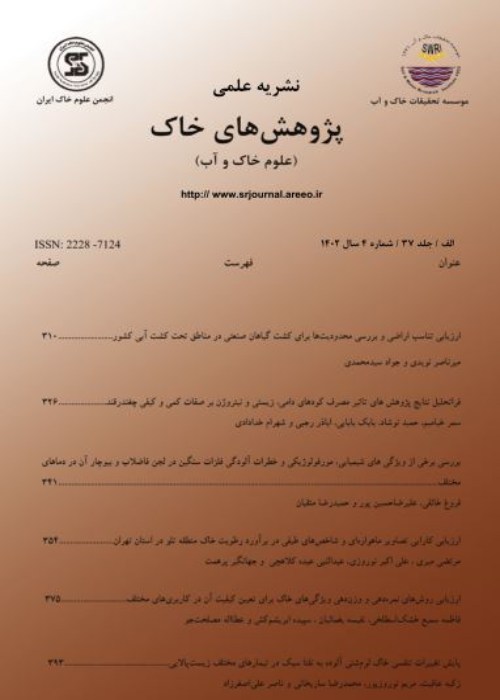Comparison of Sheep and Cow Manures Residual Effects on Some Quantitative and Qualitative Traits of Winter Wheat
Author(s):
Article Type:
Research/Original Article (دارای رتبه معتبر)
Abstract:
Animal manures are valuable organic sources for soil organic matter and crop nutrition. To evaluate the residual effects of two sources of animal manure on growth and yield of winter wheat (Triticum aestivum L) Zarin variety, a field experiment was conducted at Miandoab Research Station, Agricultural and Natural Resource Research and Educational Center of West Azerbaijan, Iran. Manures were used in 2014. In the next three years, no animal manure was applied. Residual effects of manures were determined during winter growing season of 2017-19. The treatments included T1= control, T2= 50 t ha-1 cow manure, T3= 100 t ha-1 cow manure, T4= 50 t ha-1 sheep manure, and T5= 100 t ha-1 sheep manure and were used in a randomized complete block design (RCBD) with three replications. None of the plots received mineral fertilizers. The results showed that the sheep manure was more efficient than the cow manure. Plots receiving 50 t ha-1 sheep manure showed higher grain yield and harvesting index of 36% and 17%, respectively, compared to control plots, whereas, 100 t ha-1 sheep manure did not show significant yield increase compared to the T4. Significantly higher nitrogen (1.84%), potassium (0.41%), magnesium (0.12%), iron (126.40 mg.kg-1), copper (16.4 mg.kg-1), zinc (45.7 mg.kg-1) and manganese (33.35 mg.kg-1) content in grain and highest potassium (1.76%), iron (269.3 mg.kg-1), zinc (9.16 mg.kg-1) and manganese (24.08 mg.kg-1) content in wheat straw were recorded under treatment T4. The overall results indicate that organic carbon and availability of nutrients, particularly P, Zn, and Fe in the soil surface layer were significantly higher in plots receiving manures compared to the control. Before the experiment, soil organic carbon (SOC) was 0.88%. After harvest, SOC in treatments of 50 and 100 t ha-1 of cow manure increased to 0.99% and 1.36%, and in treatments of 50 and 100 t ha-1 of sheep manure, it increased to 0.94% and 1.26%, respectively. The Results demonstrated that manure application, due to its role in soil fertility improvement, is an effective strategy for efficient production of wheat and enrichment of its grain.
Keywords:
Language:
Persian
Published:
Iranian Journal of Soil Research, Volume:34 Issue: 2, 2020
Pages:
155 to 167
magiran.com/p2186337
دانلود و مطالعه متن این مقاله با یکی از روشهای زیر امکان پذیر است:
اشتراک شخصی
با عضویت و پرداخت آنلاین حق اشتراک یکساله به مبلغ 1,390,000ريال میتوانید 70 عنوان مطلب دانلود کنید!
اشتراک سازمانی
به کتابخانه دانشگاه یا محل کار خود پیشنهاد کنید تا اشتراک سازمانی این پایگاه را برای دسترسی نامحدود همه کاربران به متن مطالب تهیه نمایند!
توجه!
- حق عضویت دریافتی صرف حمایت از نشریات عضو و نگهداری، تکمیل و توسعه مگیران میشود.
- پرداخت حق اشتراک و دانلود مقالات اجازه بازنشر آن در سایر رسانههای چاپی و دیجیتال را به کاربر نمیدهد.
In order to view content subscription is required
Personal subscription
Subscribe magiran.com for 70 € euros via PayPal and download 70 articles during a year.
Organization subscription
Please contact us to subscribe your university or library for unlimited access!


